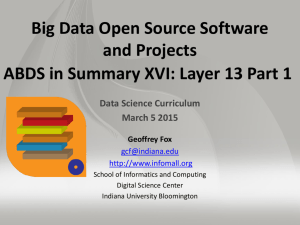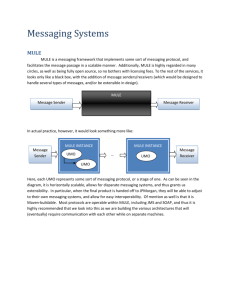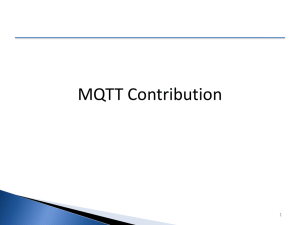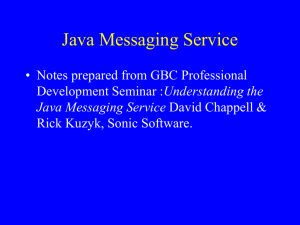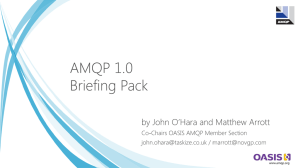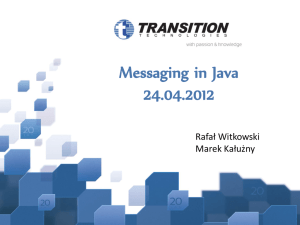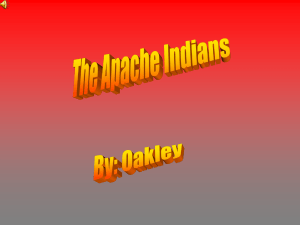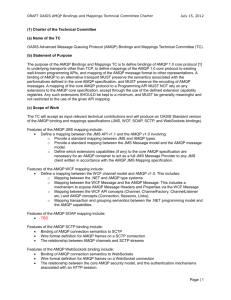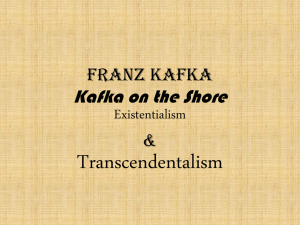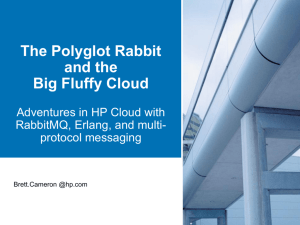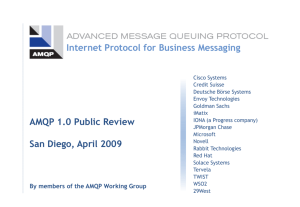PPT - Big Data Open Source Software and Projects
advertisement
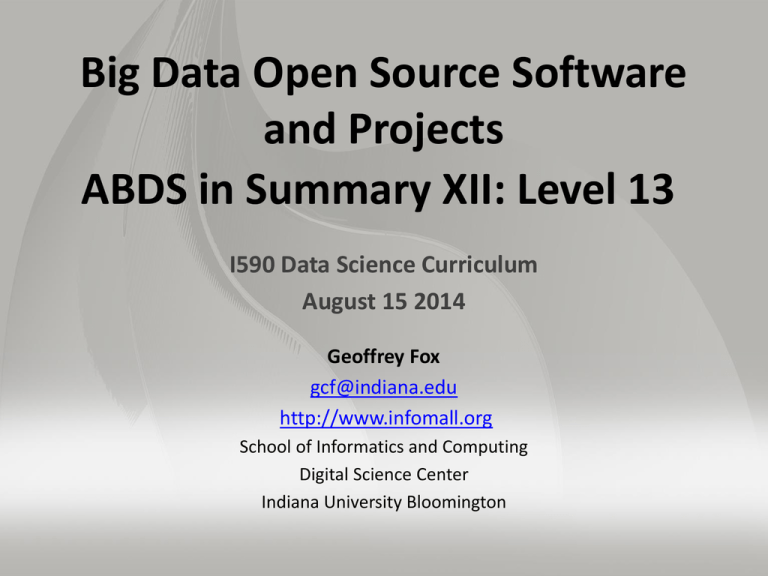
Big Data Open Source Software and Projects ABDS in Summary XII: Level 13 I590 Data Science Curriculum August 15 2014 Geoffrey Fox gcf@indiana.edu http://www.infomall.org School of Informatics and Computing Digital Science Center Indiana University Bloomington 1) 2) 3) 4) 5) 6) 7) 8) 9) 10) 11) 12) 13) 14) 15) 16) 17) HPC-ABDS Layers Message Protocols Distributed Coordination: Security & Privacy: Monitoring: IaaS Management from HPC to hypervisors: DevOps: Interoperability: Here are 17 functionalities. Technologies are File systems: presented in this order Cluster Resource Management: 4 Cross cutting at top Data Transport: 13 in order of layered diagram starting at SQL / NoSQL / File management: bottom In-memory databases&caches / Object-relational mapping / Extraction Tools Inter process communication Collectives, point-to-point, publish-subscribe Basic Programming model and runtime, SPMD, Streaming, MapReduce, MPI: High level Programming: Application and Analytics: Workflow-Orchestration: Publish-Subscribe Technology Helped by Supun Kamburugamuve Apache Kafka (LinkedIn) • http://kafka.apache.org/ • Apache Kafka is a message brokering system designed for high throughput and low latency, as well as a high level of durability and fault tolerance. It uses a publish/subscribe model, where producers publish messages to a cluster of brokers, consumers poll messages from the brokers. • Kafka was originally developed to track web site activity such as page views and searches, but it has been applied to varied activities. • Kafka was developed at LinkedIn, and was made open source in 2011. It became a top level Apache project in 2012. Kafka uses another Apache project, Zookeeper, to maintain its broker clusters. Apache ActiveMQ • http://activemq.apache.org/ • Apache ActiveMQ is a very popular publish-subscribe message broker • Mainly supports the JMS 1.1. standard. JMS is an API and not a wire protocol. • Has its own wire protocol called OpenWire and supports standard protocols like Stomp and MQTT. • ActiveMQ supports clustered brokers and networked brokers for scalability and fault tolerance. • Producers and consumers can be written in different programming languages RabbitMQ • http://www.rabbitmq.com/ • RabbitMQ is an open source messaging framework under the Mozilla Public License. • Developed to support the AMQP open messaging standard and has support available for other protocols like MQTT. • Developed using erlang programming language and boasts on its high throughput and low latency. • RabbitMQ supports clustering for fault tolerance and scalability • Any AMQP compliant client can publish messages to RabbitMQ as well as consume messages. • Python interface py-librabbitmq used by Celery Apache Qpid • https://qpid.apache.org/ • Qpid is the Apache project implementing the AMQP protocol. • The broker is mainly written in Java and has clients written in different programming languages • Support clustering for high availability Kestrel • http://robey.github.io/kestrel/ • Kestrel is a simple distributed messaging queue. • The nodes in a Kestrel cluster doesn’t communicate with each other, resulting in loosely ordered queues across the cluster. • Because of this simple design Kestrel can scale to thousands of nodes. • The project is developed at Twitter and available in Github. • Kestrel supports memcache protocol and thrift based protocol for sending and receiving messages ZeroMQ • http://zeromq.org/ • ZeroMQ is a embeddable library for creating custom messaging solutions for applications • Provides sockets that can be used to do inter-process, intra-process, TCP multicast messaging. • The sockets can be connected 1 to 1, N to N with patterns like fan-out, pub-sub etc. • The library is asynchronous in nature and provide very efficient and fast communication channels to the applications. • Primarily developed in C but the library can be used from difference programming languages like Java, PHP etc. Netty • http://netty.io/ • Netty is a NIO based Java framework which enables easy development of high performance network applications like protocol Servers and Clients. • Netty was developed at Red Hat JBoss and now available in Github under the Apache license version 2.0. • The library provides out of the box support for popular application protocols like HTTP. • The library can be used to build custom transport protocols using TCP or UDP. Public Cloud Pub/Sub • Google Cloud Pub Sub https://developers.google.com/pubsub is a publish-subscribe messaging system offered by Google as a cloud service – Supports many to many, one to many and many to one communications. – The publishers can use the HTTP API for sending the data. – The subscribers can use a pull based API or push based API for receiving the data. – The service is available as a developer preview and free of charge. – Part of Google Cloud Dataflow that also has FlumeJava and Google MillWheel • See Simple Notification Service (Amazon SNS) http://aws.amazon.com/sns/ for Amazon equivalent and • Azure Queues and Service Bus Queues (advanced functionality) http://msdn.microsoft.com/enus/library/azure/hh767287.aspx for Azure equivalent • Apache Kafka is open source capability System Features Amazon Simple Queue Azure Queue ActiveMQ MuleMQ Websphere MQ Narada Brokering AMQP compliant No No No, use OpenWire and Stomp. No No No JMS compliant No No Yes Yes Yes Yes Distributed broker No No Yes Yes Yes Yes Exactly once delivery supported Guaranteed and exactly-once Delivery guarantees Ordering guarantees Message retained Message Based on journaling Disk store uses 1 in queue for 4 accessible for 7 and JDBC drivers file/channel, TTL days days to databases. purges messages Best effort, once No ordering, delivery, duplicate Message returns messages exist more than once Publisher order guarantee Not clear. Publisher- or timePublisher order order by Network guarantee Time Protocol Access Model SOAP, HTTPbased GET/POST HTTP REST interfaces Using JMS classes Max. Message 8 KB 8 KB NA NA NA NA Buffering NA Yes Yes Yes. Yes Yes Yes Yes Yes Yes Time decoupled delivery Security Up to 4 days. Up to a max. of Support timeouts. 7 days. Based on HMACSHA1 signature. scheme Support for WSSecurity 1.0. Support for Web Services SOAP based interactions Transports HTTP/ HTTPS, SSL Subscription formats Access is to individual queues JMS, Adm. API, Message Queue and JNDI Interface, JMS JMS, WSEventing Access to Access control , SSL, end-to-end Authorization based SSL, end-to-end queues by authentication, application level on JAAS for application level HMAC SHA256 SSL for data security, and authentication data security signature communication ACLs REST interfaces REST REST Mule ESB TCP, UDP, SSL, supports TCP, HTTP/ HTTPS HTTP/S, Multicast, UDP, RMI, SSL, in-VM, JXTA SMTP and FTP Access is to individual queues REST, SOAP interactions WS-Eventing TCP, UDP, Multicast, SSL, HTTP/S TCP, Parallel TCP, UDP, Multicast, SSL, HTTP/S, IPSec SQL Selectors, JMS spec allows JMS spec allows JMS spec allows Regular expresfor SQL selectors. for SQL selectors. SQL selectors. sions, <tag, Also access to Also access to Access to indivivalue> pairs, individual queues. individual queues. dual queues. XQuery and XPath ~2010 Comparison Important Brokers changed since then Messaging Standards JMS, AMQP, Stomp, MQTT I • http://en.wikipedia.org/wiki/Java_Message_Service These are messaging standards typically used to describe messages sent from clients to brokers (like Kafka) where they are queued and inspected by subscribers • JMS Java Message Service was historically very important as first broadly used/available technology for “message oriented middleware” although commercial solutions like “MQ Series” http://en.wikipedia.org/wiki/IBM_WebSphere_MQ from IBM were available earlier. • JMS is supported by many brokers like RabbitMQ that also support the protocols AMQP, Stomp, MQTT • JMS is an API i.e. defines how accessed in software but does not define nature of messages so different implementations can not be mixed • AMQP, Stomp, MQTT http://blogs.vmware.com/vfabric/2013/02/choosingyour-messaging-protocol-amqp-mqtt-or-stomp.html are protocols i.e. nature of messages is defined so messages in these protocols should be interoperable between implementations. JMS, AMQP, Stomp, MQTT II • AMQP, which stands for Advanced Message Queuing Protocol, was designed as an open replacement for existing proprietary messaging middleware. Two of the most important reasons to use AMQP are reliability and interoperability. • http://www.amqp.org/ is an OASIS standard • AMQP is a binary wire protocol which was designed for interoperability between different vendors. Where other protocols have failed, AMQP adoption has been strong. Companies like JP Morgan use it to process 1 billion messages a day. • As the name implies, it provides a wide range of features related to messaging, including reliable queuing, topic-based publish-and-subscribe messaging, flexible routing, transactions, and security. AMQP exchanges route messages by topic, and also based on headers. • There’s a lot of fine-grained control possible with such a rich feature set. You can restrict access to queues, manage their depth, and more. Features like message properties, annotations and headers make it a good fit for a wide range of enterprise applications. • This protocol was designed for reliability at the many large companies who depend on messaging to integrate applications and move data around their organization. • In the case of RabbitMQ, there are many different language implementations and great samples available, making it a good choice for building large scale, reliable, resilient, or clustered messaging infrastructures. JMS, AMQP, Stomp, MQTT III • STOMP http://stomp.github.io/ is the Simple Text Oriented Messaging Protocol • Like AQMP, STOMP provides an interoperable wire format so that STOMP clients can communicate with any STOMP message broker to provide easy and widespread messaging interoperability among many languages, platforms and brokers. • STOMP is a very simple and easy to implement protocol, coming from the HTTP school of design; the server side may be hard to implement well, but it is very easy to write a client to get yourself connected. • STOMP does not, however, deal in queues and topics—it uses a SEND semantic with a “destination” string. The broker must map onto something that it understands internally such as a topic, queue, or exchange. • Consumers then SUBSCRIBE to those destinations. Since those destinations are not mandated in the specification, different brokers may support different types of destination. So, it’s not always straightforward to port code between brokers. JMS, AMQP, Stomp, MQTT IV • • • • • • MQTT (Message Queue Telemetry Transport) http://mqtt.org/ is a machine-to-machine (M2M)/"Internet of Things" connectivity protocol standardized in OASIS It was originally developed out of IBM’s pervasive computing team and their work with partners in the industrial sector. Over the past couple of years the protocol has been moved into the open source community, seen significant growth in popularity as mobile applications have taken off. The design principles and aims of MQTT are much more simple and focused than those of AMQP—it provides publish-and-subscribe messaging (no queues, in spite of the name) and was specifically designed for resource-constrained devices and low bandwidth, high latency networks such as dial up lines and satellite links, for example. Basically, it can be used effectively in embedded systems. One of the advantages MQTT has over more full-featured “enterprise messaging” brokers is that its intentionally low footprint makes it ideal for today’s mobile and developing “Internet of Things” style applications. In fact, companies like Facebook are using it as part of their mobile applications because it has such a low power draw and is light on network bandwidth. Some of the MQTT-based brokers support many thousands of concurrent device connections. It offers three qualities of service: 1) fire-and-forget / unreliable,2) “at least once” to ensure it is sent a minimum of one time (but might be sent more than one time), and 3) “exactly once”. MQTT’s strengths are simplicity (just five API methods), a compact binary packet payload (no message properties, compressed headers, much less verbose than something text-based like HTTP), and it makes a good fit for simple push messaging scenarios such as temperature updates, stock price tickers, oil pressure feeds or mobile notifications. It is also very useful for connecting machines together, such as connecting an Arduino device to a web service with MQTT. Inter process communication MPI • MPI or Message Passing Interface http://en.wikipedia.org/wiki/Message_Passing_Interface is dominant parallel computing technology developed by a community standardization effort – the MPI forum – buildings many previous technologies • MPI supports two basic types of communication: Point to Point and Collective • Collective communication involves many to many, one to many (Scatter) or many to one (gather) communication. It also involves reduction operations i.e. ability to form add, min, max etc. operations as messages flow through system. • MPI includes rich variety of messaging semantics allowing communication and computation to be overlapped or not • It also includes one sided operations: write to remote memory (put), a read from remote memory (get) • MPI-IO supports parallel access to disk storage • MPI just finished its third revision http://www.mpi-forum.org/ Harp • Hadoop Plugin (on Hadoop 1.2.1 and Hadoop 2.2.0) from Indiana University https://github.com/jessezbj/harp-project • Hierarchical data abstraction on arrays, key-values and graphs for easy programming expressiveness. • Collective communication model to support various communication operations on the data abstractions (will extend to Point to Point) • Caching with buffer management for memory allocation required from computation and communication Work of Judy Qiu • BSP style parallelism Bingjing Zhang • Fault tolerance with checkpointing • Architecture • Parallelism Model MapReduce Model M M M Application Map-Collective or MapCommunication Applications MapReduce Applications M M Shuffle R Map-Collective or MapCommunication Model M M Optimal Communication R M Harp Framework MapReduce V2 Resource Manager YARN
